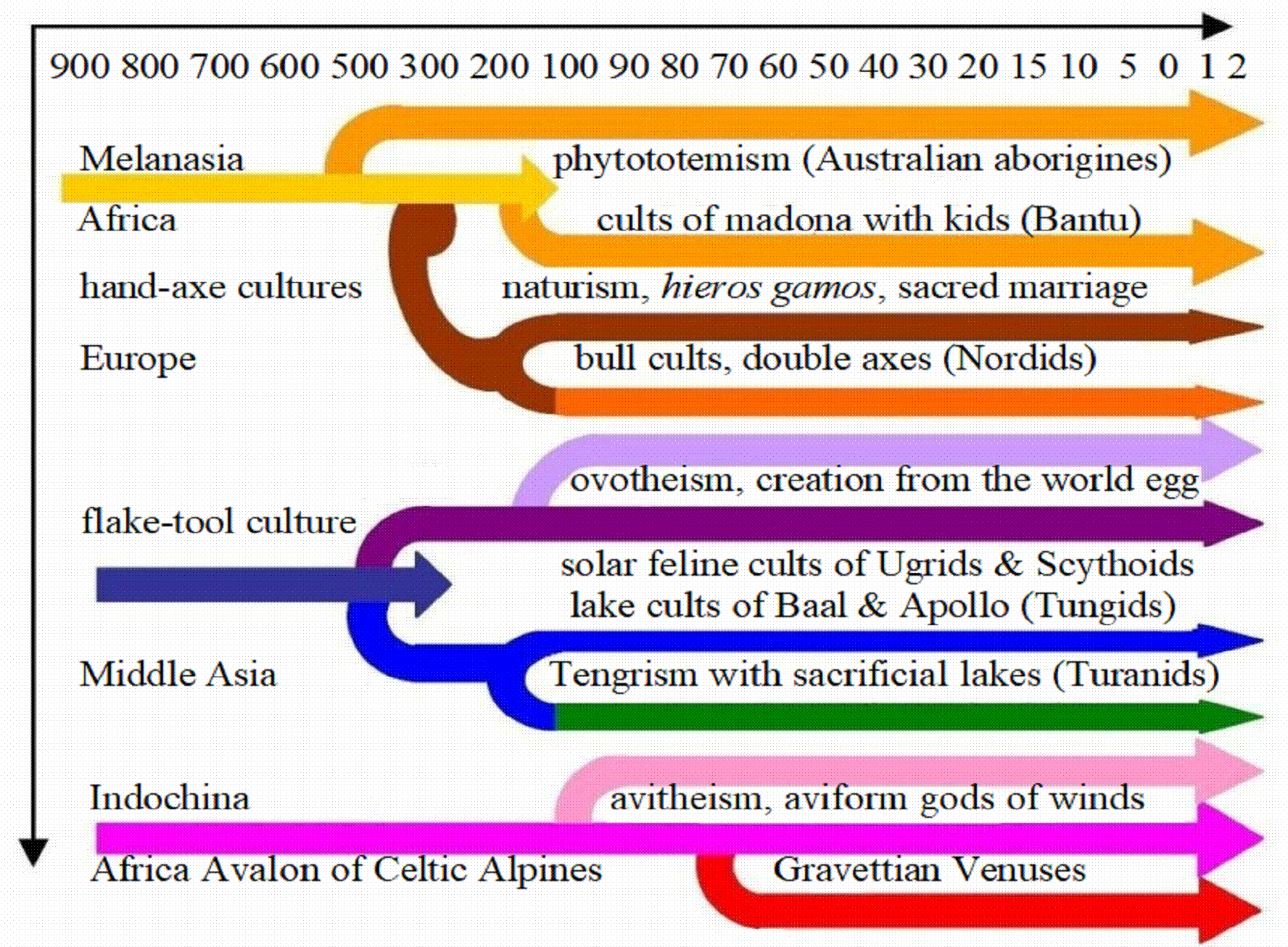|
|
|
||||||||||||
|
|
|
||||||||||||
|
|
|
|
|||||||||||
|
|
|
|
|||||||||||
|
|
|
|
|||||||||||
|
|
|
||||||||||||
|
|
|
|
|
||||||||||
|
|
The Origins of Human Religious Faiths Clickable terms are red on the yellow or green background |
|
|||||||||||
|
|
The
Theoretical Foundations of Anthropology, Ethnology and Prehistoric
Studies |
|
|||||||||||
|
|
|
|
|
||||||||||
|
The Evolutionary Tree of Human Religiogenesis and Magic
Cults of Savages (from P. Bělíček:: The Synthetic Classification of Human Phenotypes and Varieties Prague 2018, Table 8, Map p. 24) |
|
|||
|
|
Origins of the Religious Cultures
of Primordial Races
The typological screening of recent indigenous and aboriginal cultures
brings sufficient additional evidence for reconstructing Palaeolithic
lineages as well as the archaic patterns of their spiritual life. Religious
ideas originated by sacralising activities associated with alimentation and gaining
daily bread. The economic mode of subsistence was sublimated in supernatural
imagination and popular superstitions, almighty agents of everyday life were
deified as omnipotent spirits and deities. The racial group of big-game hunters
promoted cults of animal totems. They butchered mammoths as well as other
giant mammals and practiced theriomorphic totemism (zootheism). This
religion idolatrised the lords of animal species and identified their kin
with a genus of beasts. If their totem animal was the bear, they believed
that they were begotten by bears and after their death their soul will be
reborn as a bear. It would transmigrate into a zoomorphic body and resurrect
as a bear cub. The waterside fishermen confessed pisciform totemism
(ichthyotheism) praying to creatures living in waters. Besides fish they
bowed to various waterside monsters and wished to be devoured by their
fictitious king, a strong shark or a dragon. Such a fatal accident would
ensure them reincarnation into a feared predator and warrior in the reptile
body. On the other hand, tribes of herbivorous plant-gatherers gave
preference to vegetal powers and believed in phytogenous totemism
(phytotheism). They thought that they were born from plants and would die as
flowers, shrubs or trees. They lived on vegetal food and deified their source
of subsistence as sacred. Totemistic
magic prevailed in the Palaeolithic period and evolved in several distinct
stages. At first, totemistic cults classified human clansmen and foreigners
as distinct animal species without recognising their human identity. Later
times witnessed the rise of social authority attached to chieftains and
strong warriors, who grouped in men’s secret sodalities and prepared hunting
expeditions. They wore ghostlike animal masques and spooked commoners as
supernatural spirits. Such social differentiation turned totemism into animism
dividing clansmen according to age-classes, tattooing and trophies as bearers
of supernatural powers. Common clansmen feared them as forest spirits commanding
territories in the neighbourhood. |
|
In the Neolithic isolated nomadic hordes were
compelled to settle down and permeate with neighbouring clans in mixed
communities. As a result, animal totems and spirits abandoned rainforest
solitude and ascended to heavens as almighty gods. Dominant warlike tribes
seized chieftainship and bulwarked their seat in elevated hillforts (Greek acropoleis).
They forced subdued neighbours to worship their clan gods as celestial
monarchs reigning in heavens. Tribes of megalith builders worshipped ovotheism
(Latin ovum ‘egg’) declaring that the world was created from an
egg laid by the world bird nesting on the world tree. It was imagined as an
impersonation of the heavenly sun-god watching his worshippers with beaming
and blessing eyes. Another catchword might read as ‘oculotheism’ since this
god punished the infidels with blindness and blessed the faithful fidels with
wealth. A different
type of ovotheism was common to the brotherly phratries of Asiatic, Uralic
and Tibetan tribes, who were known for religions of astrotheism (Latin
aster ‘star’).1 They
worshipped stars and believed that if an old chieftain died, his souls turned
into a night star in heavens. At the same time some miraculous signs in the
sky notified clansmen that a new predestined king or dalai lama
descended to the earth in the reincarnated body of a little baby archpriest. Big-game
hunters were accustomed to nomadic life in the wake of hunted herds but when
their hunting grounds became exhausted, they had to settle down as
pastoralists indulging in warfare. Their folklore abounded in heroic sagas
and epic songs (Heldenlieder) glorifying brave warriors and their
legendary deeds. As they fought with bows and arrows, they soon discovered
their derivate in musical string instruments such as lyres, harps, cithers
and lutes. Their accompaniment helped to develop long narrative monodic
compositions known as alliterated heroic epic. The tribes of nomadic fishermen were
divided into racial groups of Tungusoid or Pelasgoid lake-dwellers and
Turcoid bog people or cliff-dwellers. The latter were reported to live in
artificial rock-cut caves or shafts hewn in seaside crags. Originally they
believed in the fish-like transmigrations of human Extract from P. Bělíček: The
Synthetic Classification of Human Phenotypes and Varieties. Prague 2018, p. 27-28 |
|

